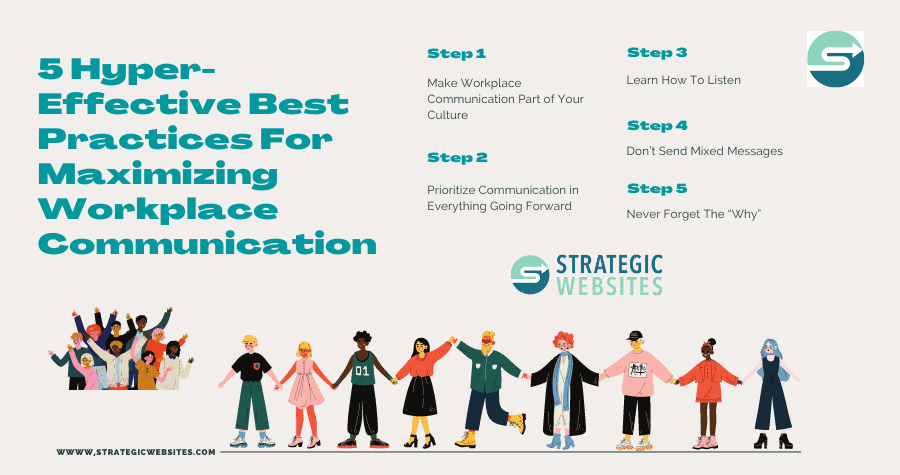Communication is the backbone of any business. In many ways, the degree of success a company experiences depends largely on how well they’re able to communicate.
When it comes to communication, there are a number of contexts we could be talking about. For example, we’re all aware of how important it is to communicate your marketing messages to your target audience in order to get more leads and drive sales.
But one area that is more often overlooked that is just as important for a company’s ongoing success – internal workplace communication.
Why is Workplace Communication Important?
Research shows that businesses that prioritize workplace communication are over three times more likely to outperform the competition. The simple reality is that if employees don’t know what’s going on, it’s more likely that things will go wrong.
Part of this is emotional. In order to feel valued as an employee, the minimum you expect is to know about any new developments or key changes in direction. If you treat your staff as just “worker bees,” they’ll eventually act like that. There will be less creativity, out-of-the-box thinking, and all of those intangible elements that make one business more successful than another.
This is just as true between employees, as having a sense of community is a key factor in morale and productivity. It’s impossible to properly motivate your workforce unless there is a solid culture of communication. You’re happy to keep your customers in the loop with newsletters, so the same level of attention should be paid to your internal staff.
When your teams are motivated and communicating properly, you’ll notice them begin to go above and beyond, taking part in dynamic ideation sessions or proactively finding solutions to shared problems.
There’s no doubt that a company with a bedrock of strong communication has an inherent competitive advantage. But how do you achieve this?
1. Make Workplace Communication Part of Your Culture
Creating a strong culture is the only way to implement changes that aren’t just surface-level. Let’s put it this way, if you simply tell people they need to communicate more, it’s unlikely to last. Even with the best will in the world, communication is not straightforward and it takes a structured approach to change the root of the problem.
The best way to change workplace culture is to lead by example. As the leader, you need to be seen to communicate openly. Encourage dialog, create frameworks, open up avenues for communication. You can even incorporate it into your company values, if you wish.
The point is, by making a cultural shift and creating a space for communication to take place, you are more likely to see it take root.
2. Prioritize Communication in Everything Going Forward
Communication has to be a priority at all levels and in all business actions. The first step is to set aside specific times for communication. This should take place at an individual level, a team level, and even a company level (if that’s within your power). Monthly team meetings, breakfast one-on-ones, team huddles – whatever way you choose to do it, make sure it’s set in stone.
From there, you need to begin incorporating communication best practices into your work going forward. If you see someone has done a good job, let the team know. If you think people are nervous about sharing, set up an anonymous suggestion box.
Most importantly of all, during specific projects, provide clear communication outlines. This encompasses everything from updates and ensuring coworkers are kept up to date to how to communicate with clients.
3. Learn How To Listen
As a leader or manager, we all want to do what’s right for our teams. Often, we go about this by implementing new strategic approaches or initiatives, such as the ones we’ve outlined above.
But it’s also true that managers are often swamped with work. This means that your example of communication can accidentally become performative rather than authentic. You’re doing all the right things and establishing the correct frameworks – but are you really listening?
While this is entirely understandable, it’s something you should be mindful of. We all pick up on people’s body language and if you don’t appear to be actively taking in what your employees are saying, it can be difficult to achieve the results you want. When someone is speaking to you – especially about something important – don’t think about what’s next on your list or look around the room.
Pay attention to them and actually hear what they have to say. There’s no trick to this! It’s just about being present.
4. Don’t Send Mixed Messages
Brevity may be the soul of wit – but clarity is the cornerstone of communication. If you set someone a task or are offering feedback, make sure everything you say is specific, empathetic, and actionable.
Some of this will be systematic in nature. Your internal file organization, for example, needs to be up to date. If you’re using a CRM, make sure it’s always easy for users to access information. The same is true for any shared drive folders, internal messages, etc.
Beyond organization, it’s also essential to clearly convey an individual’s purpose within the team or a project and how it relates to their skill set. Not only does this give them responsibility and accountability, but it shows you recognize and value what they have to offer.
For example, you could say something like, “I’m counting on you to create the proposal. I’ve seen your ability to write persuasively before, so I think you’re the right person for the job. Use this proposal as a template and could you have it by Friday? Thanks.”
5. Never Forget The “Why”
Building on the last example, it’s always good to remind individuals and teams of the reason they’re valuable to the company and the part they play in its ongoing growth. We all want to feel like we’re making a contribution and the second we feel that our work doesn’t matter, that’s the moment we mentally switch off.
As a leader, you’re used to working daily with a strategic overview of the company. You can see how different pieces of the puzzle fit together to drive growth or achieve a purpose. It’s not the same for those on the front lines actually carrying out the tasks who are more often bogged down in daily tasks.
Where possible, ensure that everyone knows the “why” behind a project or change in company direction. Having an understanding of the big picture can really alter an individual’s perspective – especially when they have to carry out a task that is repetitive or boring.
The fact is, if employees have a grasp of why their job is important, they’re going to show much more engagement, both physically and emotionally.
Communication is About Consistency
By following each of these five best practices, you can ensure that all the pillars of communication are addressed. That means implementing frameworks, improving organization, and ensuring that your employees’ emotional needs and sense of worth are taken into account.
That said, at the end of the day, consistency is key. If you’re currently experiencing problems with a lack of communication, change isn’t going to happen over night. It’s going to take deliberate and authentic work on your part to see long-term results.
Even so, it’s more than worth the effort. By creating and promoting a culture of communication in your company, you will lift your employees up, making them happier, healthier, and more productive.
Need help with your internal communications? Feel free to reach out and we’ll get back as soon as we can!




